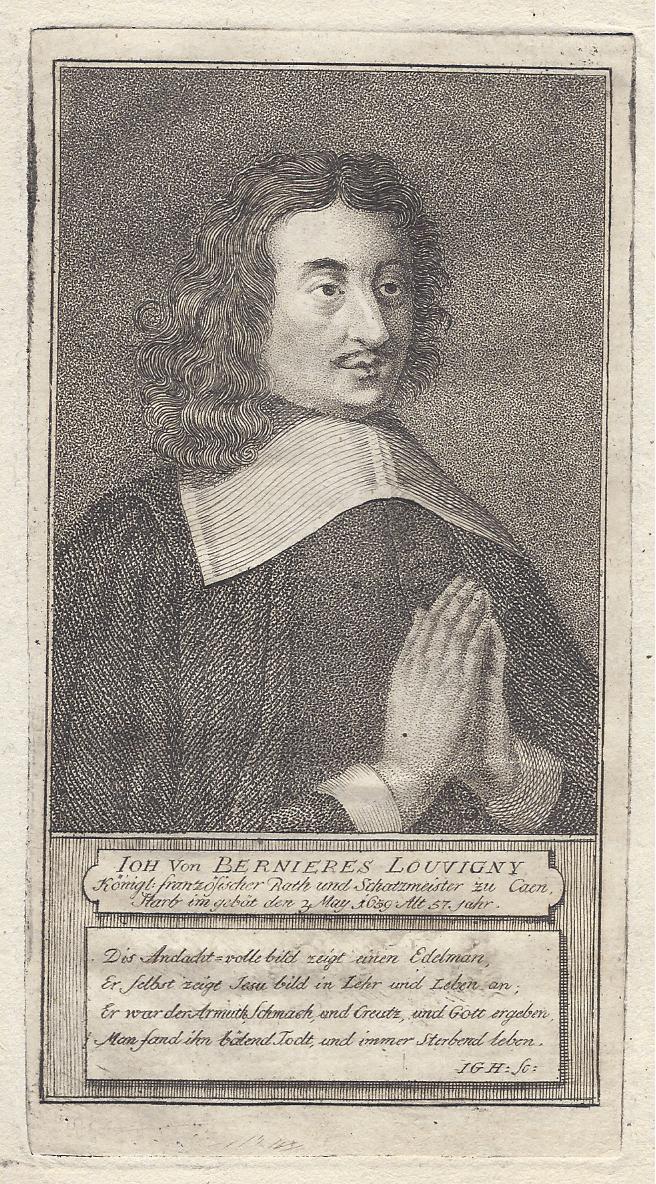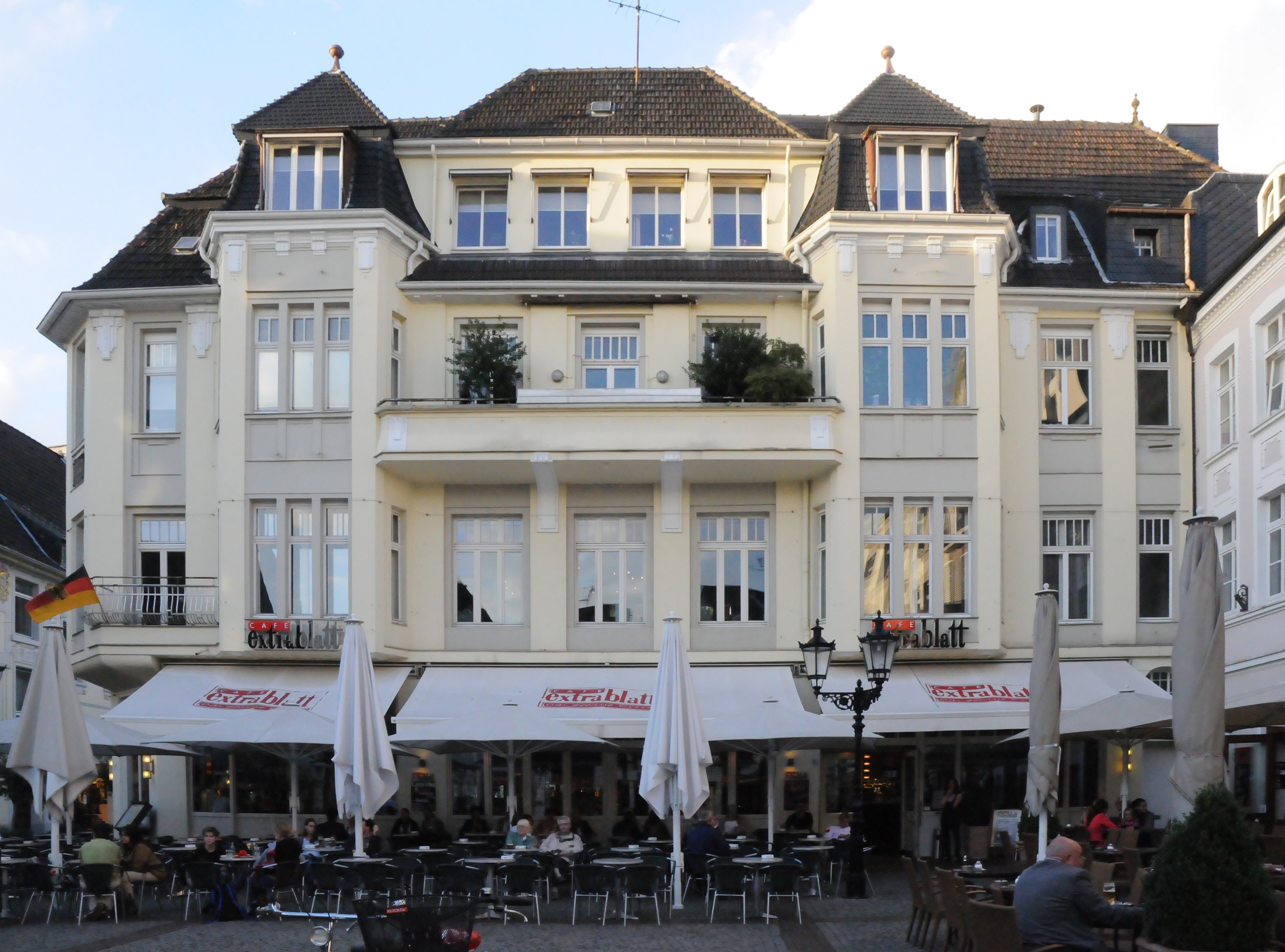|
Jean De Bernieres-Louvigny
Jean de Bernieres-Louvigny (1602 – 3 May 1659) was a French mystic and an important lay spiritual writer. Life Jean de Bernieres-Louvigny was born in the city of Caen, Normandy in 1602 and he worked as a Royal finance officer. After a conversion experience, he began to live in a hermitage as an ascetic. He was never a cleric, but devoted himself to the spiritual leadership of many people, and also wrote some sacred works, which were not printed until after his death. He led a contemplative, but also a charitable life. He died in his hometown on May 3, 1659. The German mystic of the reformed Pietism school, Gerhard Tersteegen Gerhard Tersteegen (25 November 1697 – 3 April 1769), was a German Reformed religious writer and hymnist. Life Tersteegen was born in Moers, at that time the principal city of a county belonging to the House of Orange-Nassau that formed a Pro ... (1697-1769) translated his works into German in 1727 for the first time.Max Goebel, Geschichte d ... [...More Info...] [...Related Items...] OR: [Wikipedia] [Google] [Baidu] |
Mysticism
Mysticism is popularly known as becoming one with God or the Absolute, but may refer to any kind of ecstasy or altered state of consciousness which is given a religious or spiritual meaning. It may also refer to the attainment of insight in ultimate or hidden truths, and to human transformation supported by various practices and experiences. The term "mysticism" has Ancient Greek origins with various historically determined meanings. Derived from the Greek word μύω ''múō'', meaning "to close" or "to conceal", mysticism referred to the biblical, liturgical, spiritual, and contemplative dimensions of early and medieval Christianity. During the early modern period, the definition of mysticism grew to include a broad range of beliefs and ideologies related to "extraordinary experiences and states of mind." In modern times, "mysticism" has acquired a limited definition, with broad applications, as meaning the aim at the "union with the Absolute, the Infinite, or God". This li ... [...More Info...] [...Related Items...] OR: [Wikipedia] [Google] [Baidu] |
Caen
Caen (, ; nrf, Kaem) is a commune in northwestern France. It is the prefecture of the department of Calvados. The city proper has 105,512 inhabitants (), while its functional urban area has 470,000,Comparateur de territoire INSEE, retrieved 20 June 2022. making Caen the second largest urban area in and the 19th largest in France. It is also the third largest commune in all of Normandy after and Rouen. It is located inland ... [...More Info...] [...Related Items...] OR: [Wikipedia] [Google] [Baidu] |
Normandy
Normandy (; french: link=no, Normandie ; nrf, Normaundie, Nouormandie ; from Old French , plural of ''Normant'', originally from the word for "northman" in several Scandinavian languages) is a geographical and cultural region in Northwestern Europe, roughly coextensive with the historical Duchy of Normandy. Normandy comprises mainland Normandy (a part of France) and the Channel Islands (mostly the British Crown Dependencies). It covers . Its population is 3,499,280. The inhabitants of Normandy are known as Normans, and the region is the historic homeland of the Norman language. Large settlements include Rouen, Caen, Le Havre and Cherbourg. The cultural region of Normandy is roughly similar to the historical Duchy of Normandy, which includes small areas now part of the departments of Mayenne and Sarthe. The Channel Islands (French: ''Îles Anglo-Normandes'') are also historically part of Normandy; they cover and comprise two bailiwicks: Guernsey and Jersey, which are B ... [...More Info...] [...Related Items...] OR: [Wikipedia] [Google] [Baidu] |
Hermitage (religious Retreat)
A hermitage most authentically refers to a place where a hermit lives in seclusion from the world, or a building or settlement where a person or a group of people lived religiously, in seclusion. Particularly as a name or part of the name of properties its meaning is often imprecise, harking to a distant period of local history, components of the building material, or recalling any former sanctuary or holy place. Secondary churches or establishments run from a monastery were often called "hermitages". In the 18th century, some owners of English country houses adorned their gardens with a "hermitage", sometimes a Gothic ruin, but sometimes, as at Painshill Park, a romantic hut which a "hermit" was recruited to occupy. The so-called Ermita de San Pelayo y San Isidoro is the ruins of a Romanesque church of Ávila, Spain that ended up several hundred miles away, to feature in the Buen Retiro Park in Madrid. Western Christian tradition A hermitage is any type of domestic dwelli ... [...More Info...] [...Related Items...] OR: [Wikipedia] [Google] [Baidu] |
Ascetic
Asceticism (; from the el, ἄσκησις, áskesis, exercise', 'training) is a lifestyle characterized by abstinence from sensual pleasures, often for the purpose of pursuing spiritual goals. Ascetics may withdraw from the world for their practices or continue to be part of their society, but typically adopt a frugal lifestyle, characterised by the renunciation of material possessions and physical pleasures, and also spend time fasting while concentrating on the practice of religion or reflection upon spiritual matters. Various individuals have also attempted an ascetic lifestyle to free themselves from addictions, some of them particular to modern life, such as money, alcohol, tobacco, drugs, entertainment, sex, food, etc. Asceticism has been historically observed in many religious traditions, including Buddhism, Jainism, Hinduism, Islam, Christianity, Judaism, Stoicism and Pythagoreanism and contemporary practices continue amongst some religious followers. The practition ... [...More Info...] [...Related Items...] OR: [Wikipedia] [Google] [Baidu] |
Cleric
Clergy are formal leaders within established religions. Their roles and functions vary in different religious traditions, but usually involve presiding over specific rituals and teaching their religion's doctrines and practices. Some of the terms used for individual clergy are clergyman, clergywoman, clergyperson, churchman, and cleric, while clerk in holy orders has a long history but is rarely used. In Christianity, the specific names and roles of the clergy vary by denomination and there is a wide range of formal and informal clergy positions, including deacons, elders, priests, bishops, preachers, pastors, presbyters, ministers, and the pope. In Islam, a religious leader is often known formally or informally as an imam, caliph, qadi, mufti, mullah, muezzin, or ayatollah. In the Jewish tradition, a religious leader is often a rabbi (teacher) or hazzan (cantor). Etymology The word ''cleric'' comes from the ecclesiastical Latin ''Clericus'', for those belonging ... [...More Info...] [...Related Items...] OR: [Wikipedia] [Google] [Baidu] |
German Mystic
The Friends of God (German: Gottesfreunde; or gotesvriunde) was a medieval mystical group of both ecclesiastical and lay persons within the Catholic Church (though it nearly became a separate sect) and a center of German mysticism. It was founded between 1339 and 1343 during the Avignon Papacy of the Western Schism, a time of great turmoil for the Catholic Church. The Friends of God were originally centered in Basel, Switzerland and were also fairly important in Strasbourg and Cologne. Some late-nineteenth century writers made large claims for the movement, seeing it both as influential in fourteenth-century mysticism and as a precursor of the Protestant Reformation. Modern studies of the movement have emphasised the derivative and often second-rate character of its mystical literature, and its limited impact on medieval literature in Germany. Some of the movement's ideas still prefigured the Protestant reformation. Name The name "Friends of God" may have been influenced by vario ... [...More Info...] [...Related Items...] OR: [Wikipedia] [Google] [Baidu] |
Pietism
Pietism (), also known as Pietistic Lutheranism, is a movement within Lutheranism that combines its emphasis on biblical doctrine with an emphasis on individual piety and living a holy Christian life, including a social concern for the needy and disadvantaged. It is also related to its non-Lutheran (but largely Lutheran-descended) Radical Pietism offshoot that either diversified or spread into various denominations or traditions, and has also had a contributing influence over the interdenominational Evangelical Christianity movement. Although the movement is aligned exclusively within Lutheranism, it had a tremendous impact on Protestantism worldwide, particularly in North America and Europe. Pietism originated in modern Germany in the late 17th century with the work of Philipp Spener, a Lutheran theologian whose emphasis on personal transformation through spiritual rebirth and renewal, individual devotion, and piety laid the foundations for the movement. Although Spener did not ... [...More Info...] [...Related Items...] OR: [Wikipedia] [Google] [Baidu] |
Gerhard Tersteegen
Gerhard Tersteegen (25 November 1697 – 3 April 1769), was a German Reformed religious writer and hymnist. Life Tersteegen was born in Moers, at that time the principal city of a county belonging to the House of Orange-Nassau that formed a Protestant enclave in the midst of a Catholic country. After being educated at the gymnasium of his native town, Tersteegen was for some years apprenticed to a merchant. He soon came under the influence of Wilhelm Hoffman, a Pietistic revivalist, and devoted himself to writing and public speaking, withdrawing in 1728 from all secular pursuits and giving himself entirely to religious work. He also had a great influence on radical Pietism. His writings include a collection of hymns, such as ''Das geistliche Blumengärtlein'' mystics and of Julian of Norwich. He died in Mülheim, North Rhine-Westphalia. Sermons Tersteegen was well known for his deeply spiritual sermons. People crowded into his home to hear him speak of the things of God. Som ... [...More Info...] [...Related Items...] OR: [Wikipedia] [Google] [Baidu] |
17th-century French Writers
The 17th century lasted from January 1, 1601 ( MDCI), to December 31, 1700 ( MDCC). It falls into the early modern period of Europe and in that continent (whose impact on the world was increasing) was characterized by the Baroque cultural movement, the latter part of the Spanish Golden Age, the Dutch Golden Age, the French ''Grand Siècle'' dominated by Louis XIV, the Scientific Revolution, the world's first public company and megacorporation known as the Dutch East India Company, and according to some historians, the General Crisis. From the mid-17th century, European politics were increasingly dominated by the Kingdom of France of Louis XIV, where royal power was solidified domestically in the civil war of the Fronde. The semi-feudal territorial French nobility was weakened and subjugated to the power of an absolute monarchy through the reinvention of the Palace of Versailles from a hunting lodge to a gilded prison, in which a greatly expanded royal court could be more easily ... [...More Info...] [...Related Items...] OR: [Wikipedia] [Google] [Baidu] |
17th-century French Male Writers
The 17th century lasted from January 1, 1601 ( MDCI), to December 31, 1700 ( MDCC). It falls into the early modern period of Europe and in that continent (whose impact on the world was increasing) was characterized by the Baroque cultural movement, the latter part of the Spanish Golden Age, the Dutch Golden Age, the French ''Grand Siècle'' dominated by Louis XIV, the Scientific Revolution, the world's first public company and megacorporation known as the Dutch East India Company, and according to some historians, the General Crisis. From the mid-17th century, European politics were increasingly dominated by the Kingdom of France of Louis XIV, where royal power was solidified domestically in the civil war of the Fronde. The semi-feudal territorial French nobility was weakened and subjugated to the power of an absolute monarchy through the reinvention of the Palace of Versailles from a hunting lodge to a gilded prison, in which a greatly expanded royal court could be more easily k ... [...More Info...] [...Related Items...] OR: [Wikipedia] [Google] [Baidu] |










